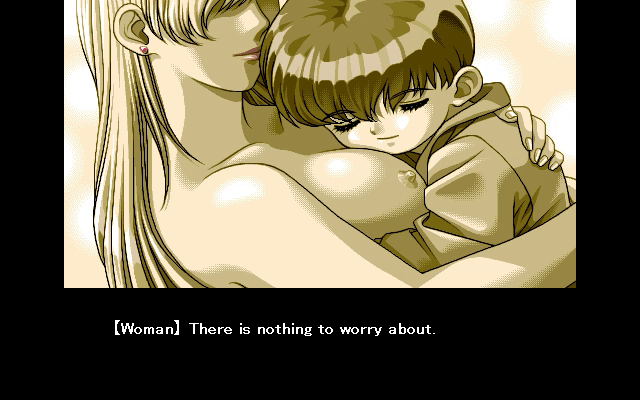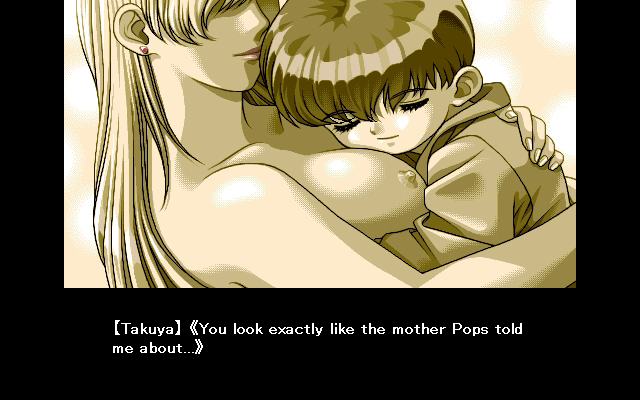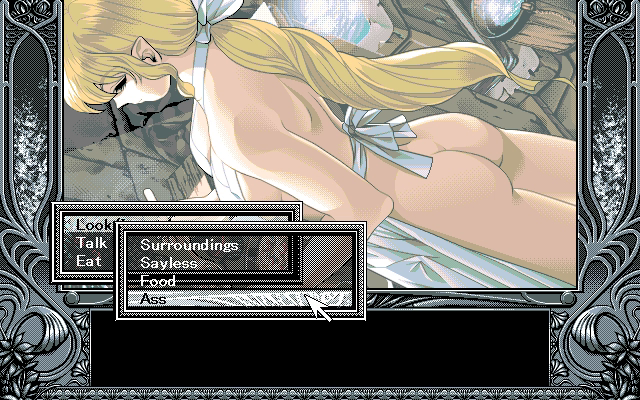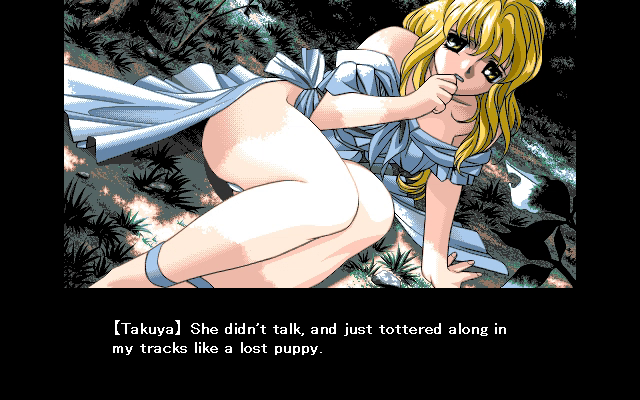Whereas Ayumi–Takuya is deliberate incest that is not true incest, Kanna–Takuya is unintentional but true incest. Takuya never recognizes that Amanda is Kanna’s mother despite the characteristic manacle on her left arm, and Kanna never realizes that her boyfriend is her missing father. Kanno presents both relationships as positive for the parties involved without reservation. In both story routes, Takuya literally saves the woman’s life and, in Kanna’s case, restores her self-love through incest. While the player can engage with either Ayumi or Kanna first, these two examples of the Oedipal pattern lead to the Epilogue, where, at the end of this pipeline, Takuya proves less resistant to sex with his own biological daughter than he did to his stepmother Ayumi. If Ayumi–Takuya does not seem troubling, then, for the unaware player, Kanna–Takuya must be less so. However, in the Epilogue, after the player has already been inured to the Oedipal pattern and its intensification and combination with pedophilia, Kanno reveals that Takuya is Kanna’s father. The player may now recognize, in this Oedipal pipeline, that Takuya has already had sex with his daughter. He has already violated this taboo. This realization facilitates acceptance of Takuya’s final sexual partner being his now underaged daughter in the true ending, acceptance, in other words, of the culmination of the Oedipal pattern in deliberate true incest.
Prior to Yu-no–Takuya comes a penultimate Oedipal relationship. In first act of the Epilogue, Takuya spends four years living at the idyllic edge of an alien world called Dela Grante, Kaytia’s homeland. There, he meets Sayless (or Celes), a woman identical to and a surrogate for Kaytia. Her fair skin and long, blonde hair render Sayless functionally identical to the one other character with this appearance except for Yu-no: Kaytia. Aside from the glimpse of Kaytia in the Prologue, Koudai’s description of his wife in his Memorandum as a young woman with “radiant, golden hair and pale, spotless skin” applies equally to Sayless, as does Kanna’s description of Kaytia as “very quiet, and always smiling” (emphasis mine).
Kanno makes explicit Sayless’s role as a surrogate for Kaytia the moment she appears. The player does not first meet Sayless in the Epilogue. On the Mio route, Takuya may encounter a vision of Sayless beneath Triangle Mountain. Before the player sees Sayless herself, her maternal voice reassures Takuya that “there is nothing to worry about” under the same image of Kaytia holding a baby Takuya to her bare chest that opens YU-NO.

The first lines Takuya says to Sayless, his future wife, are, “…Mom? …Are you my mother?” and, a few lines later, “You’re my mother, aren’t you…?

The Epilogue, then, fulfills Takuya’s subsequent wish to see this alleged mom’s “face… if only just once”—and a lot more of her. When meeting her in the Epilogue, too, Takuya quickly remarks on Sayless’s familiar appearance. After beginning his relationship with Sayless, Takuya describes her with the same language of “nostalgia” with which he likens Kanna to Kaytia: “[Sayless] had a nostalgic aura about her. Yeah… for some reason, she had that same aura I’d felt in the past…”

The player later views a nude Sayless from behind to elicit sexual comments as she cooks food for Takuya, a maternal act. This also recalls the player exploring Kanna’s nape and panties via the point-and-click ADMS interface as she prepares breakfast. Like Kaytia, Sayless is even a priestess of the God Emperor of Dela Grante. Because incest is not a matter of the least concern in the world of YU-NO so that, given the opportunity, Takuya would without doubt have sex with his mother, Sayless may as well be Kaytia.
More submissive than even Ayumi, save for the episode when Sayless flees into the desert, the player’s silent wife behaves more like a pet than a partner. Upon meeting her in Dela Grante, Takuya already dehumanizes the woman he identifies with his mother: “I’m starting to feel like I’m handling some kind of animal…” Reflecting on their relationship after her death, Takuya returns to the point:
